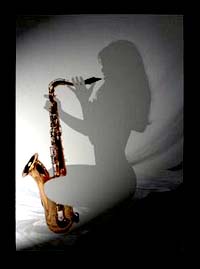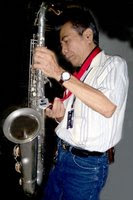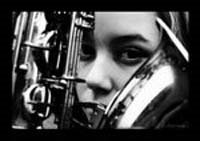
By: Yoyok CR.
(classroom teacher in the school saxophone Y2K Music Studio)
There are some requirements in the playing saxophone al: Breathing techniques, Tone (Ambusheer) & Fingering Inhalation: using breath stomach and chest, stomach breath means no way to take a breath properly because the stomach is able to hold 12 liters of air, while the chest only 5 liters of air.
How to practice belly breath sbb al. :
Drag breath with the mouth ago stored in the stomach, so stomach tends to swell up in the air felt stomach waist up, and remove the hiss slowly (efficient) and do a repeat (of the chest when the chest is called the breath, but if the chest does not move means the stomach and belly breathing stomach was done correctly). Drag breath with the mouth ago stored in the stomach, so stomach swell ago issued sedikit2 with hiss (as if stomach pumping air out sebagian2). Respiratory suggested that we use a stomach capable of blowing saxophone stronger and longer, while the breath chest may be used for emergency (when we have to draw breath quickly)
Tone: it is the most important play in the saxophone, the tone / sound is rounded / bold / bright akan fluty in and hear the music in harmony with other instruments. How to practice: Practice long tones in a way stacato at the beginning of the ringing tone for the whole or any chromatic tone basis. Practice long tones slowly (piano) and a tone loud (forte) or cressendo and decressendo. Drill down and tone up Stacato practice and legato Minimal practice long tones every day at least 15 minutes
FINGERING: must use discipline techniques that speed, accuracy and fine each of the valve does not beep pressed. How to practice fingering so good to be al: Distance keys with finger / valve must remain close to the console, so there is no distance when the finger is not pressing keys. Practice in a certain tone repeated a difficult position as C to D, C to D #, D # to E, F to F #, F to G #, F # to G #, G # to A, G kw A #, G # to A #, A # to B , # A to C, B to C etc. Train nada2 chord such as C - E - G - C, C - F, A, C, D, G, B, D and patern / etude / al blues scale (CD-FF # # #-GA), pentatonic (CDEGAC) Sigh Reading and Primavista Reading beam is not one of the requirements in the playing music, because the beam is not reading the media to play saxophone in a group with other music instrument (band, Ensemble, orchestra) so neat, accurate and in accordance with the Arrangement is expected by arranger, composer & conductor. Besides not reading the useful beam to get to know and learn lagu2 standards, pop and jazz music from buku2 anywhere and learn scale2, patern and contoh2 improvised from buku2. Primavista that is not read in keakurasian beam directly and quickly, so to be able to practice the primavista not read blocks each day (at least 30 minutes).
Improvisation: Improvisation can be learned with a few meet the following requirements. : The understanding of the chord and its contents, so it must learn to study saxophone piano / guitar. Practice patern / major etude, major6, dominan7, major7, major9, major11, major13, minor, minor6, minor7, minor9, diminished, augtemented, whole tone etc. Practice such as the blues scale CD #, F, F #, A #, C, such as the pentatonic scale CDEGAC etc.. The solvegio able to identify the tone is not in the numbers. Many of the world such as CD saxophonist David Sanborn, Ernie Watts, Charlie Parker, Dave Koz, Stan Getz, pacuito de Riviera, dave vallentine, Winton marsallis etc. For those who just want to learn to play the song with the saxophone of course must be the order of the song (bait1, bait2, Reff, bait3 or chorus) and not know the song, at least be able to feel nada2's song (by feeling / by heart).
Posted by COMMUNITY saxophone at 02:32 0 comments









No comments:
Post a Comment